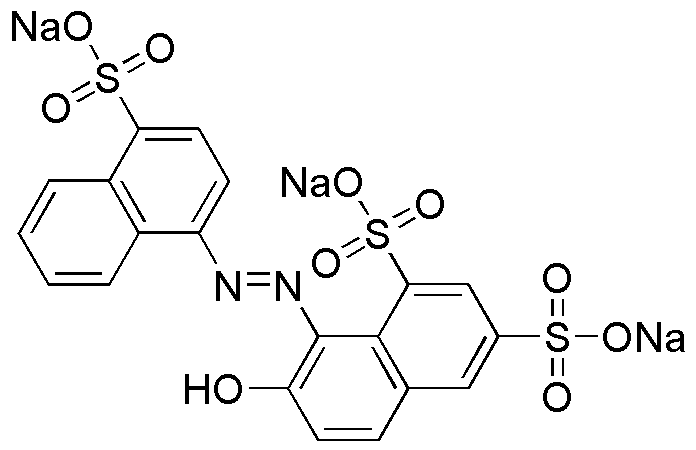New Coccine is widely utilized in research focused on:
- Dye Industry: It serves as a vibrant dye for textiles, providing bright colors that are resistant to fading, making it ideal for fashion and home décor applications.
- Biological Staining: In laboratories, it is used for staining biological specimens, enhancing visibility under a microscope, which is crucial for biological research and diagnostics.
- Food Coloring: New Coccine is employed as a food additive, offering a safe and appealing color to various food products, thus enhancing their marketability.
- Cosmetics: The compound is also found in cosmetic formulations, where it provides color to products like lipsticks and eyeshadows, ensuring they meet consumer preferences for vibrant shades.
- Environmental Monitoring: Its application in environmental science includes tracking pollutants in water bodies, helping researchers assess the impact of industrial activities on ecosystems.
General Information
Properties
Safety and Regulations
Applications
New Coccine is widely utilized in research focused on:
- Dye Industry: It serves as a vibrant dye for textiles, providing bright colors that are resistant to fading, making it ideal for fashion and home décor applications.
- Biological Staining: In laboratories, it is used for staining biological specimens, enhancing visibility under a microscope, which is crucial for biological research and diagnostics.
- Food Coloring: New Coccine is employed as a food additive, offering a safe and appealing color to various food products, thus enhancing their marketability.
- Cosmetics: The compound is also found in cosmetic formulations, where it provides color to products like lipsticks and eyeshadows, ensuring they meet consumer preferences for vibrant shades.
- Environmental Monitoring: Its application in environmental science includes tracking pollutants in water bodies, helping researchers assess the impact of industrial activities on ecosystems.
Documents
Safety Data Sheets (SDS)
The SDS provides comprehensive safety information on handling, storage, and disposal of the product.
Product Specification (PS)
The PS provides a comprehensive breakdown of the product’s properties, including chemical composition, physical state, purity, and storage requirements. It also details acceptable quality ranges and the product's intended applications.
Certificates of Analysis (COA)
Search for Certificates of Analysis (COA) by entering the products Lot Number. Lot and Batch Numbers can be found on a product’s label following the words ‘Lot’ or ‘Batch’.
*Catalog Number
*Lot Number
Certificates Of Origin (COO)
This COO confirms the country where the product was manufactured, and also details the materials and components used in it and whether it is derived from natural, synthetic, or other specific sources. This certificate may be required for customs, trade, and regulatory compliance.
*Catalog Number
*Lot Number
Safety Data Sheets (SDS)
The SDS provides comprehensive safety information on handling, storage, and disposal of the product.
DownloadProduct Specification (PS)
The PS provides a comprehensive breakdown of the product’s properties, including chemical composition, physical state, purity, and storage requirements. It also details acceptable quality ranges and the product's intended applications.
DownloadCertificates of Analysis (COA)
Search for Certificates of Analysis (COA) by entering the products Lot Number. Lot and Batch Numbers can be found on a product’s label following the words ‘Lot’ or ‘Batch’.
*Catalog Number
*Lot Number
Certificates Of Origin (COO)
This COO confirms the country where the product was manufactured, and also details the materials and components used in it and whether it is derived from natural, synthetic, or other specific sources. This certificate may be required for customs, trade, and regulatory compliance.


